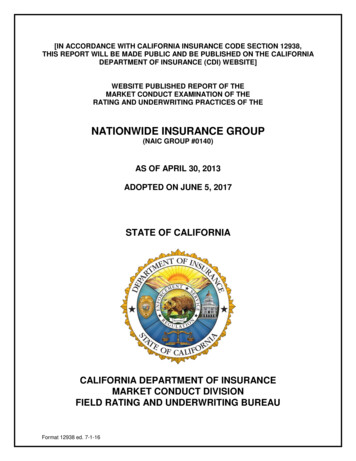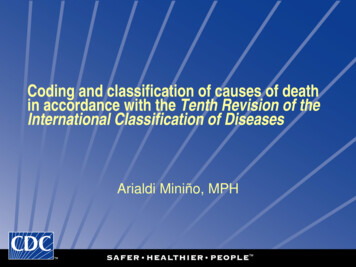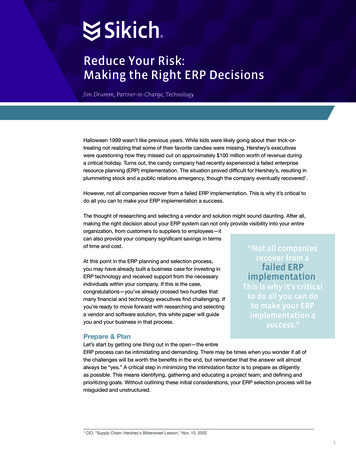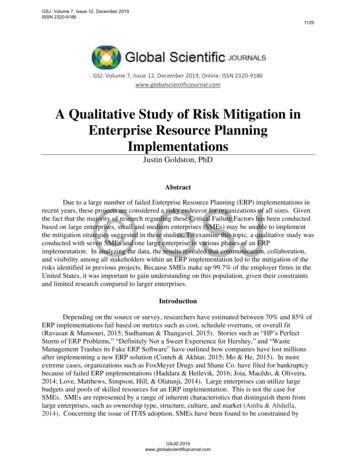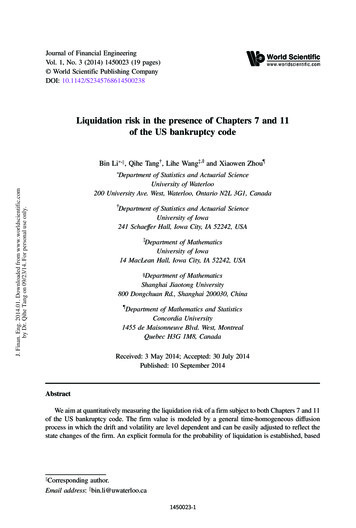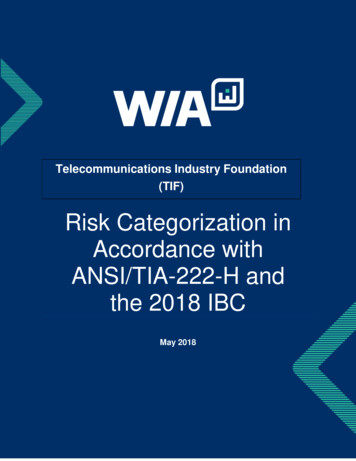
Transcription
Telecommunications Industry Foundation(TIF)Risk Categorization inAccordance withANSI/TIA-222-H andthe 2018 IBCMay 2018
NOTICE OF DISCLAIMER AND LIMITATIONS OF LIABILITYTHE TELECOMMUNICATIONS INDUSTRY FOUNDATION (TIF) AND THETELECOMMUNICATIONS INDUSTRY ASSOCIATION (TIA) DO NOT ENFORCE ORMONITOR COMPLIANCE WITH THE CONTENTS OF THE DOCUMENT. TIA ANDTHE TELECOMMUNICATIONS INDUSTRY FOUNDATION DO NOT CERTIFY,INSPECT, TEST OR OTHERWISE INVESTIGATE PRODUCTS, DESIGNS ORSERVICES OR ANY CLAIMS OF COMPLIANCE WITH THE CONTENTS OF THEDOCUMENT.ALL WARRANTIES, EXPRESS OR IMPLIED, ARE DISCLAIMED, INCLUDINGWITHOUT LIMITATION, ANY AND ALL WARRANTIES CONCERNING THEACCURACY OF THE CONTENTS, ITS FITNESS OR APPROPRIATENESS FOR APARTICULAR PURPOSE OR USE, ITS MERCHANTABILITY AND ITSNONINFRINGEMENT OF ANY THIRD PARTY’S INTELLECTUAL PROPERTYRIGHTS. TIA AND THE TELECOMMUNICATIONS INDUSTRY FOUNDATIONEXPRESSLY DISCLAIMS ANY AND ALL RESPONSIBILITIES FOR THE ACCURACYOF THE CONTENTS AND MAKES NO REPRESENTATIONS OR WARRANTIESREGARDING THE CONTENT’S COMPLIANCE WITH ANY APPLICABLE STATUTE,RULE OR REGULATION, OR THE SAFETY OR HEALTH EFFECTS OF THECONTENTS OR ANY PRODUCT OR SERVICE REFERRED TO IN THE DOCUMENTOR PRODUCED OR RENDERED TO COMPLY WITH THE CONTENTS.TIA AND THE TELECOMMUNICATIONS INDUSTRY FOUNDATION SHALL NOT BELIABLE FOR ANY AND ALL DAMAGES, DIRECT OR INDIRECT, ARISING FROM ORRELATING TO ANY USE OF THE CONTENTS CONTAINED HEREIN, INCLUDINGWITHOUT LIMITATION ANY AND ALL INDIRECT, SPECIAL, INCIDENTAL ORCONSEQUENTIAL DAMAGES (INCLUDING DAMAGES FOR LOSS OF BUSINESS,LOSS OF PROFITS, LITIGATION, OR THE LIKE), WHETHER BASED UPONBREACH OF CONTRACT, BREACH OF WARRANTY, TORT (INCLUDINGNEGLIGENCE), PRODUCT LIABILITY OR OTHERWISE, EVEN IF ADVISED OF THEPOSSIBILITY OF SUCH DAMAGES. THE FOREGOING NEGATION OF DAMAGES ISA FUNDAMENTAL ELEMENT OF THE USE OF THE CONTENTS HEREOF, ANDTHESE CONTENTS WOULD NOT BE PUBLISHED BY TIA OR THETELECOMMUNICATIONS INDUSTRY FOUNDATION WITHOUT SUCHLIMITATIONS. THE PURPOSE OF THIS GUIDE (WHITE PAPER) IS TO PROVIDE ANOVERVIEW FOR EDUCATION AND INFORMATION. THIS DOCUMENT IS NOT ASTANDARD.DRAFT1
THIS PUBLICATION REPRESENTS THE COMMENTS AND OPINIONS OF THEAUTHORS AND IS NOT INTENDED TO SUPERSEDE ANY TIA OR OTHERINDUSTRY STANDARDS. THE PUBLICATION OF THIS DOCUMENT DOES NOTREPRESENT THE POSITION OR ENDORSEMENT OF TIA OR TIF.DISCLAIMER: TIF does not endorse or promote anyproduct, service, company or provider.DRAFT2
PrefaceThe ANSI/TIA-222 Standard and the IBC have traditionally adopted the methodology of the ASCE 7Standard for determining the minimum loading requirements for new and existing structures. The ASCE 7Standard has evolved since the publication of the ANSI/TIA 222-G Standard (Rev G). The release ofRevision H of the ANSI/TIA-222 Standard (Rev H) in January 2018 and the publication of the 2018International Building Code (IBC) brings these standards up-to-date with the latest ASCE 7 Standard (ASCE7-16).IntroductionThe Rev H minimum wind, ice and earthquake loading requirements for a new or existing structure arebased on reliability requirements.Reliability requirements are established by considering theconsequences (risk) of failure of a structure depending on its use and location. For a communicationstructure, use is defined by the types of services provided by the equipment supported by the structure.Rev G had 3 categories of structures based on reliability requirements. Rev H now has 4 categories andhas updated the terminology used to describe the categories from “Structure Class” to “Risk Category” tobe consistent with ASCE 7 and the IBC.The order of increasing reliability remains the same numbering from the lowest reliability (category I) to thehighest reliability (category IV). Using 4 categories allows the TIA-222 Standard to better categorize thewide range of use (services) and locations of communication structures. This approach is consistent withthe intent of the ASCE 7 standard where the definitions of risk for each category is presented in generalterms allowing the interpretation and application of risk categories and their associated loadingrequirements to communication structures and other specialty structures.The Rev H risk categories based on the services provided by a communication structure and the risk tohuman life and/or damage to surrounding facilities in the event of failure were established by a consensusprocess in accordance with ANSI and have been accepted by the IBC.The use and description of communication structures for each of the 4 risk categories are provided in Table2-1 of the Rev H standard and is reproduced at the end of this paper with permission from TIA.The intent of this document is to provide clarity and insight regarding the Risk Category for a new or existingcommunication structure by comparing the risk categories from Rev H (Table 2-1) to the risk categoriesdefined in IBC for buildings and other structures.The authors of this paper have provided commentary for each of the risk categories. The commentariesare opinions of the authors and do not represent any form of endorsement by TIA, ASCE or IBC.DRAFT3
Risk CategoriesRisk categories for new and existing communication structures are based on considerations such asprimary use, location, proximity to other facilities, redundancy of the services provided, site hardeningrequirements, etc. For each higher Risk Category, the wind, ice and earthquake loading requirementsincrease which results in a progressively lower probability that a failure would occur due to a design loadbeing exceeded over the life of a structure. As an example, the following table illustrates how the probabilityof failure due to wind loading reduces as the Risk Category increases and how the design wind speedincreases accordingly.DRAFT4
Extreme Wind Loading Based on Risk CategoryRiskCategoryReturnPeriod50-yr Probabilityof ExceedanceExample DesignWind Speed, MPHI300 years15%106II700 years7%114III1700 years3%122IV3000 years1.6%127The Rev H return periods and probabilities of exceedance based on Risk Category for wind, ice andearthquake loading were adopted from ASCE 7 and are identical for the IBC and the Rev. H Standard. Thewind speeds tabulated above are shown as a typical example. The design wind speeds for a specific areamay vary.Following are the definitions of risk categories, first per ANSI/TIA-222-H (Rev. H) Table 2-1, followed by thedefinitions from the 2018 International Building Code (IBC).RISK CATEGORY IANSI/TIA-222-H: Structures that due to use or location represent a low risk to human life and/or damageto surrounding facilities in the event of failure.Structures in this category are used for services that are optional and/or where an extensive delay inreturning the services would be acceptable such as: redundant wireless antennas; low-power radio accessnodes (small cell); single-appurtenance supporting structures that allow for rapid repair or replacement,residential wireless and conventional 2-way radio communications; television, radio and scanner reception;wireless cable; amateur and CB radio communications.2018 IBC: Buildings and other structures that represent a low hazard to human life in the event of failure,including but not limited to: DRAFTAgricultural facilitiesCertain temporary facilities5
Minor storage facilitiesAuthor’s Commentary: The TIA and IBC definitions share the same “low risk/hazard to human life” terms.Failure of structures classified as Risk Category I would not be expected to endanger the general publicand the loss of use of the structure would be limited to the private user of the services provided or wouldhave a minimum impact on the well-being of the general public.RISK CATEGORY IIANSI/TIA-222-H: Structures that due to use or location represent a moderate risk to human life and/ordamage to surrounding facilities in the event of failure.Structures in this category are used primarily for redundant services (i.e. services that may be provided byother means) such as: commercial wireless communications (cellular, PCS, 3G, LTE, 4G, 5G, etc.);television and radio broadcasting; community access television (CATV); microwave communications; nonhardened sites that support antennas or equipment that may be used for redundant communications bypolice and fire departments, first responders, etc. during emergencies and small wind turbines.This category applies to all structures except those identified in Risk Categories I, III, and IV.2018 IBC: Buildings and other structures except those listed in Risk Categories I, III and IV.Author’s Commentary: Risk Category II is the default category for Rev H unless otherwise specified in theprocurement specification for a new structure or the modification of an existing structure. For the IBC, thiscategory is for all structures not specifically classified as conforming to another risk category. Risk CategoryII includes the vast majority of commercial communication structures and buildings such as CommercialMobile Radio Services (CMRS), AM/FM Radio Broadcast, Television Transmission and MicrowaveCommunications as recognized by the FCC. This includes communication structures that may be used bypolice, fire and first responders during emergencies when there are alternate means of communicationsavailable. The Rev H definition includes the term moderate risk.The Rev H risk categorization depends on the primary use of the communication structure, not on whethera particular service provided, such as cellular communications, “could be” used during an emergency asjust one of the methods available for communication.RISK CATEGORY IIIANSI/TIA-222-H: Structures that due to use or location represent a substantial risk to human life and/ordamage to surrounding facilities in the event of failure.Structures with the potential to cause mass disruption (loss of power, transportation, water, etc.) of day-today civilian life in the event of failure.Structures in this category are used for communications across non-redundant and hardened networkssuch as: civil or national defense; rescue or disaster operations; military and navigation facilities.DRAFT6
2018 IBC: Buildings and other structures that represent a substantial hazard to human life in the event offailure, including but not limited to: Buildings and other structures whose primary occupancy is public assembly with an occupantload greater than 300.Buildings and other structures containing Group E occupancies with occupant load greaterthan 250.Buildings and other structures containing educational occupancies for students above the 12 thgrade with an occupant load greater than 500.Group I-2 occupancies with an occupant load of 50 or more residential care recipients but nothaving surgery or emergency treatment facilities.Group I-3 occupancies.Any other occupancy with an occupant load greater than 5,000.Power-generating stations, water treatment facilities for potable water, wastewater treatmentfacilities and other public facilities not included in Risk Category IV.Buildings and other structures not included in Risk Category IV containing quantities of toxicor explosive materials that:o Exceed maximum allowable quantities per control area as given in Table 307.1(1) or307.1(2) or per outdoor control area in accordance with the International Fire Code;o Are sufficient to pose a threat to the public if released.Author’s Commentary: The TIA and IBC definitions share the same “substantial risk/hazard to human life”terms. Risk Category III applies to communication structures that in the event of their collapse could impactsurrounding facilities that support operations that are necessary for day-to-day civilian life or when theservices provided by a communication structure for such operations are not available by other means andthere is a contractual agreement to provide and maintain a hardened communication site.The Rev H definition for Risk Category III includes the terms “non-redundant” and “hardened”. Examplesare provided of services that may not have alternative communication services (i.e. non-redundant). Theterm “hardened” is a new term for Rev H. The definition provided in Rev H is provided below. It should benoted that the term “hardened” applies to the entire communication system including such related items asback-up power, site security, etc. and not just to the structure supporting the service.Hardened Network: A network intended to provide the level of reliability and resiliency of an emergencycommunication system during and immediately following a natural or manmade disaster in accordance witha service level agreement with the operator of the emergency communication system that specifiesrequirements including, but not limited to, the following: protection from storm damage, immediate andlong-term clean power backup systems, surge protection for electronics, monitoring, security andmaintenance schedules.RISK CATEGORY IVANSI/TIA-222-H: Structures that due to use or location represent a substantial hazard to the community inthe event of failure.DRAFT7
Structures in this category are those that in the event of failure would threaten the functionality or integrityof facilities that are designated as Risk Category IV facilities.2018 IBC: Buildings and other structures designated as essential facilities, including but not limited to: Group I-2 occupancies having surgery or emergency treatment facilities.Fire, rescue, ambulance and police stations and emergency vehicle garages.Designated earthquake, hurricane or other emergency shelters.Designated emergency preparedness, communications and operations centers and otherfacilities required for emergency response.Power-generating stations and other public utility facilities required as emergency backupfacilities for Risk Category IV structures.Buildings and other structures containing quantities of highly toxic materials that:o Exceed maximum allowable quantities per control area as given i
Standard has evolved since the publication of the ANSI/TIA 222-G Standard (Rev G). The release of Revision H of the ANSI/TIA-222 Standard (Rev H) in January 2018 and the publication of the 2018 International Building Code (IBC) brings these standards up-to-date with the latest ASCE 7 Standard (ASCE 7-16). Introduction The Rev H minimum wind, ice and earthquake loading requirements for a File Size: 717KBPage Count: 15


